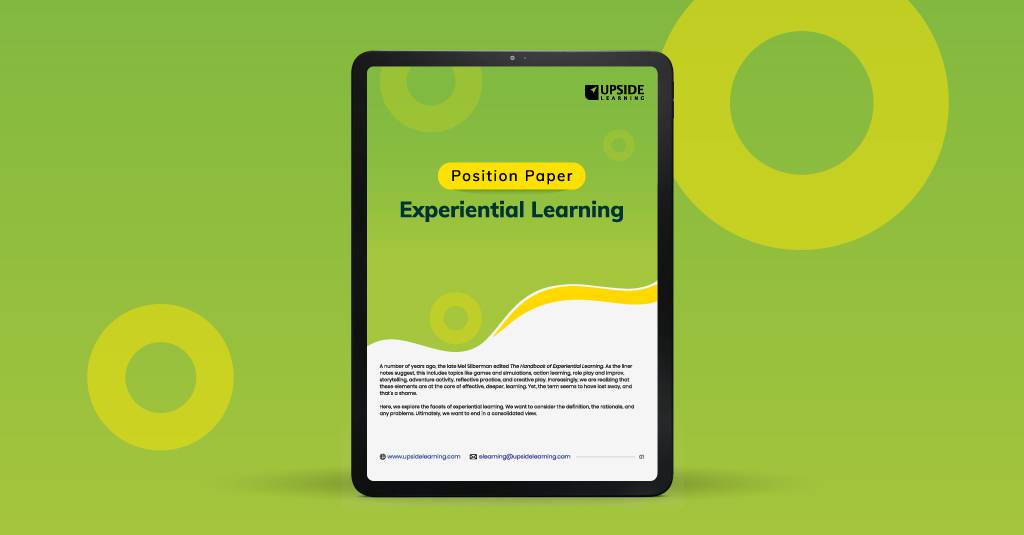Yes, I know haven’t posted anything interesting last few days. That’s because I’ve been in training this week; and would you believe it was Retail Sales training. What’s an instructional designer doing attending sales training?
Let me start with some background. As the eLearning development movement gathers momentum, organizations that wouldn’t typically consider eLearning are giving it a shot. Amongst these organizations are training companies; traditionally, I’ve always thought of training companies as the ones who deliver dowdy instructor-led training. Boy was I mistaken.
One of our newest customers is just one of these training companies. We’ve been tasked with converting their Retail Sales Training seminar into an eLearning package. While they sent over the material they use for the seminar, it was evident that it wasn’t going to be enough. In the interest of smoothening instructional development, the company offered to conduct the retail sales training seminar for our instructional designers. This is probably the best way for instructional designers to get a handle on the content and to understand what sort of learning experience is delivered in the classroom. It was also an opportunity both to understand what the seminar is about and to interact with individuals who deliver instructor-led-training. We often design ILT, but rarely have a chance to interact with the Trainers who deliver it.
So we jumped at it; and the seminar was scheduled. Organized in our board room, since we wanted to video record the delivery in case we miss elements. Everything went swimmingly over the three days – the content was excellent, the trainer’s delivery quite good despite an apparent language barrier (the trainer was a Dutch native, who spoke reasonable English) and we learnt a fair bit about one on one retail sales.
What we learnt about ILT and the delivery of engaging instruction was key, our learning retail sales was just a side-light. I think there are four primary areas my learning focused around:
1. Instructor pace, interaction and its relation to engagement – The trainers ability to control the pace of content delivery was impressive, as was the interaction fostered with individual members of the audience. A lot of this was obviously non-verbal in nature, but it was fascinating to watch. I noticed that the level of engagement in the audience varied with the pace and type of interaction the trainer used. We can’t really draw a parallel in eLearning with regards to the pace as the user sets pace; however, the link between interaction and engagement is significant. More interaction leads to more engagement, up to a point. Beyond that, interaction starts to distract and reduces engagement. Common sense, but not commonly implemented in eLearning programs.
2. The importance of Cultural Context – In eLearning context tends to be viewed very narrowly, more to do with language translation than ‘cultural content and context’. Trainers on the other hand, have to keep cultural context constantly in play. For instance, the source examples from a culture that they use may not always apply in cross-cultural contexts. Trainers overcome this by using intuition and experience; they also tend to have large numbers of instances. They can choose to present or refrain from presenting an instance based on the cultural make-up of their audience. Sadly, this (intelligent presentation of instances) is very difficult (read expensive) to accomplish in eLearning. Designers working on electronic instruction need to choose the instances in the content carefully, allowing for some appropriateness across cultural contexts.
3. The need to inject emotion (Trainer identifies with learner) – trainers use frequent ‘emotion injections’ to get the audience moving in a certain direction. They accomplish this in a variety of ways (which I’m not getting into) but the result almost always seems to excite the audience and drive them in a certain direction. While this may seem counter-productive in some situations (it probably is) I’d like to have a similar injection of emotion into eLearning, it sorely lacks right now. Contrast with games, which leverage emotion, if a little differently, as well.
4. Dump the drivel, focus on the key message – As in most human interactions, after the initial focus has worn off; the interactions wander off in varied direction. Humans talk about this and that, but the trainer is tasked with bringing the interaction back on track. In eLearning there is no human to monitor and mediate the interaction. So if you have content in there that’s ‘good-to-know’ vs. ‘need-to-know’ you can expect learners to be distracted from the key message – what they need to learn. For eLearning designers its simple: focus on the message (the outcome), dump the unnecessary details. If you still ‘have to/must have/can’t do without’ additional details, hide them from the learner at first glance. Let the first layer of information you present be limited to the key message; let them dig into another layer if they want additional information.














